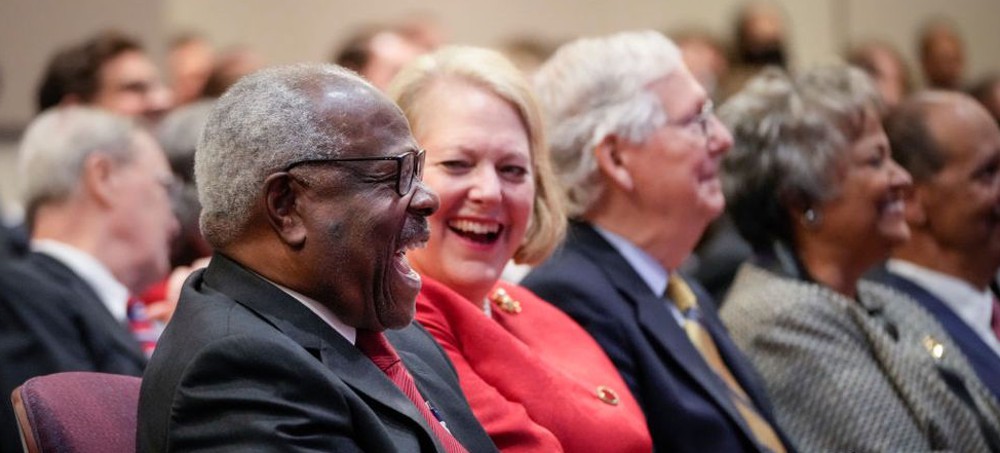The Curious Case of Ginni Thomas
Charles Pierce Esquire Ginni Thomas is the wife of Supreme Court Justice Clarence Thomas and a supporter of extreme right-wing causes. (photo: Drew Angerer/Getty)
Ginni Thomas is the wife of Supreme Court Justice Clarence Thomas and a supporter of extreme right-wing causes. (photo: Drew Angerer/Getty) The Curious Case of Ginni Thomas
Charles Pierce Esquire
One does not idly accuse the Supreme Court of corruption, but come on.
The Thomases have long posed a unique quandary in Washington. Because Supreme Court justices do not want to be perceived as partisan, they tend to avoid political events and entanglements, and their spouses often keep low profiles. But the Thomases have defied such norms. Since the founding of the nation, no spouse of a sitting Supreme Court justice has been as overt a political activist as Ginni Thomas. In addition to her perch at the Council for National Policy, she founded a group called Groundswell with the support of Stephen K. Bannon, the hard-line nationalist and former Trump adviser. It holds a weekly meeting of influential conservatives, many of whom work directly on issues that have come before the court.
Ginni Thomas insists, in her council biography, that she and her husband operate in “separate professional lanes,” but those lanes in fact merge with notable frequency.
I am a longtime fan of that dry NYT wit.
This situation is appalling. As the NYT points out, it has been a gaping wound in the Court’s ethical reputation ever since Thomas was elevated to the bench in the wake of his, ahem, contentious confirmation process. (And who can forget the episode Ginni Thomas made an X Files late night phone call to Anita Hill? That was cool.) The Times also illustrates that Justice Thomas himself has the same devil-may-care attitude toward rules of conduct that his wife has.
The reporting uncovered new details on the Thomases’ ascent: how Trump courted Justice Thomas; how Ginni Thomas used that courtship to gain access to the Oval Office, where her insistent policy and personnel suggestions so aggravated aides that one called her a “wrecking ball” while others put together an opposition-research-style report on her that was obtained by The Times; and the extent to which Justice Thomas flouted judicial-ethics guidance by participating in events hosted by conservative organizations with matters before the court. Those organizations showered the couple with accolades and, in at least one case, used their appearances to attract event fees, donations and new members.
So this ideological corruption was set in stone for the couple long before Ginni Thomas apparently waded hip-deep into the institutional side of the January 6 insurrection. It is now abundantly clear that the effort to overturn the election had a violent side and a sub rosa judicial strategy as well. Whether this constitutes one insurrection or two, they shared the same goal—preventing the elected president from taking office, and inflicting El Caudillo del Mar-A-Lago on the nation for at least another four years.
But her role went deeper, and beyond C.N.P. Action. Dustin Stockton, an organizer who worked with Women for America First, which held the permit for the Ellipse rally, said he was told that Ginni Thomas played a peacemaking role between feuding factions of rally organizers “so that there wouldn’t be any division around January 6.” “The way it was presented to me was that Ginni was uniting these different factions around a singular mission on January 6,” said Stockton, who previously worked for Bannon. “That Ginni was involved made sense—she’s pretty neutral, and she doesn’t have a lot of enemies in the movement.”
By contrast, and regardless of what you may think of John Roberts, as the NYT piece makes clear, the Chief Justice has taken a radically opposite—and far more savory—tack.
He refrains from attending partisan legal forums, like those at the Federalist Society. And his wife, Jane, stepped down as a litigator at her law firm after his appointment. Justice Thomas, however, “believes that human beings have free will to chart our own course,” said Helgi Walker, a former Thomas clerk and a partner at Gibson Dunn. “And I have no doubt that applies, perhaps especially so, to his wife.” That said, she added, he “takes direction from no one but the law.”
This, of course, is all my bollocks. There is no more predictable vote on the Court than that of Clarence Thomas. He “takes direction” from his own calcified ideology, and from his bone-deep sense of personal grievance from his confirmation process. And, if the Times is to be believed, he doesn’t have to “take directions” from his wife, the wingnut whisperer. They walk in each other’s footsteps.
